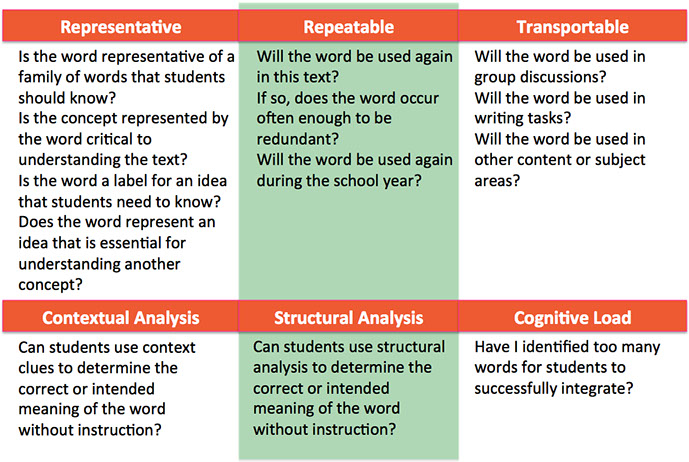Teaching Secondary Reading
A Resource for Improving Academic Literacy with Adolescents ©2015
Teaching Vocabulary
Vocabulary understanding is a key measure of content knowledge. Technical and discipline-specific vocabulary is often central to learning, especially in history, science, and math. Which of those terms should be taught? What are some effective strategies for teaching them? This page addresses those questions. For much more on vocabulary, visit Susan Ebbers' excellent Vocabulogic blog.
Which Terms Should Be Taught?
According to Fisher and Frye (2011), research suggests that "students need explicit instruction in word meanings, repeated exposure to words, opportunities for wide reading, and experiences using the words in the presence of peers." But not every word needs to be taught. Choosing which words are worthy of teaching is the first important step in vocabulary instruction. In order to assist teachers in that step, Fisher & Frey consulted well-known vocabulary researchers to produce the framework below.

Another way of choosing words to teach is by identifying Brick and Mortar Terms. "Brick" terms are the content-specific vocabulary related to the unit at hand. "Mortar" terms are connective, transitional, or directional and are the mortar, or glue that holds together academic ideas. Mortar terms appear across content areas. For example,
- "Provide examples of each the following types of government: democracy, monarchy, and oligarchy."
- Brick terms: government, democracy, monarchy, oligarchy
- Mortar terms: provide, example, different
2. "Analyze the theme of the story and how the protagonist grew as a result of the resolution."
- Brick terms: theme, protagonist, resolution
- Mortar terms: analyze, result of
See the Prezi below, by teacher Debra Engers, for more examples:
The Academic Word List (AWL) is a third way to identify words to teach. The AWL is a list of 570 of the most frequently occurring academic words found in secondary and post-secondary school texts. They are organized as families of words, with 10 sublists from most to least frequently encountered. Sublists 1 to 5 are generally found in grades 6 to 8, and sublists 6 to 10 are encountered in high school and college. If words in the texts you are teaching can also be found in the AWL, they are definitely worth teaching.
 An excellent resource aimed at grades 4-8 that uses the AWL is Word Generation, which provides "weekly units about controversial topics each with brief lessons for middle school teachers in all academic subjects." Word Generation was developed by Catherine Snow's team at Harvard and includes targeted resources for ELLs.
An excellent resource aimed at grades 4-8 that uses the AWL is Word Generation, which provides "weekly units about controversial topics each with brief lessons for middle school teachers in all academic subjects." Word Generation was developed by Catherine Snow's team at Harvard and includes targeted resources for ELLs.
What Are Best Practices for Teaching Vocabulary?
This Blachowicz article identifies 7 best practices in vocabulary instruction. After reading the article, click on each of the boxes below for more information, resources, and links.
Vocabulary learning...
7 ...Is long lasting when students use words in meaningful ways.
More on best practices in teaching vocabulary can be found at Kimberly Tyson's toolkit and blog, tips from Edutopia on teaching vocabulary and Common Core vocabulary, tips on teaching hard words from the Teaching Channel, and essential strategies for teaching vocabulary from Sage Publications.
The views and opinions expressed on unofficial pages of California State University, Dominguez Hills faculty, staff or students are strictly those of the page authors.
The content of these pages has not been reviewed or approved by California State University, Dominguez Hills.